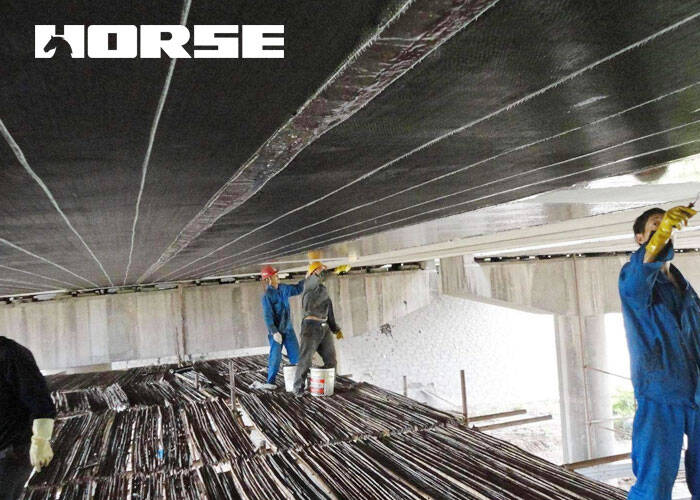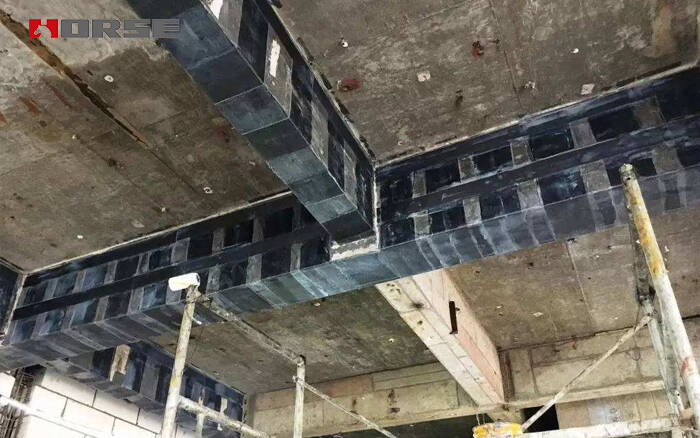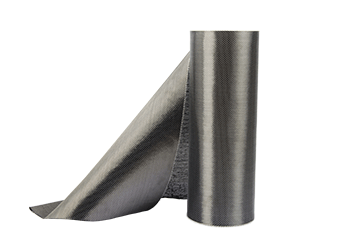Solutions
Horse Construction offers full range of structural strengthening materials with technical supports, documentation supports, products supports, project supports.
Reinforcement Countermeasures With Carbon Fiber Wrap Method

Reinforcement countermeasures for masonry structure with carbon fiber wrap
In terms of the implementation of on-site reinforcement of building brick masonry structures, the construction unit can discuss different carbon fiber cloth stress ratios and cloth layer reinforcement effects through simulation experiments and finite element analysis. Then, the feasibility analysis of carbon fiber cloth reinforcement is carried out based on the actual stress ratio of the brick masonry structure, and the carbon fiber cloth layer is determined.
Under normal circumstances, construction personnel must use two or more layers of carbon fiber cloth to meet the needs of building brick masonry structure reinforcement. In terms of actual engineering renovation and reinforcement, more than 2 layers of carbon fiber cloth are selected for the reinforcement of the masonry structure. If the number of carbon cloth exceeds 3 layers, other reinforcement methods need to be selected. Because the utilization rate of carbon fiber cloth is very low, the reinforcement effect of choosing more than 3 layers of carbon fiber cloth materials in time is relatively limited, and the material costs that need to be consumed are relatively high, which is not economical.
Technicians can use experimental simulations to study the tensile capacity and bearing capacity of building brick masonry structures, analyze the ultimate bearing capacity of the structure, and provide feasible schemes for on-site reinforcement of carbon fiber.
If the height-to-width ratio of the building's masonry structure is small, the construction personnel can achieve the goal of improving the structural bearing capacity through on-site reinforcement of carbon fiber cloth. If the height and width of the masonry of the building are relatively large, the carbon fiber cloth reinforcement method will have a great limitation on the bearing capacity of the masonry structure.
When the stress ratio of other structures of the building is less than 0.4, the on-site reinforcement effect of carbon fiber cloth is limited. The construction personnel first need to analyze the structural reinforcement design plan, determine the relationship between the compressive strength of the masonry structure and the superstructure load, and analyze the feasibility of the carbon fiber reinforcement technology. If the stress ratio of the masonry structure exceeds 0.6, other reinforcement methods are selected.
Because when the stress of the masonry structure is high, although the carbon fiber cloth has a better reinforcement effect, the utilization rate of the carbon fiber cloth is low, and the required reinforcement cost is higher. If the stress ratio of the masonry structure is within 0.4 to 0.6, carbon fiber cloth can be selected for reinforcement.

Bridge reinforcement countermeasures with carbon fiber wrap
In the reconstruction and reinforcement of highway and bridge projects, the construction personnel need to combine with the specific requirements of the engineering design and formulate a reasonable structural design plan.
During the on-site reinforcement of the bridge structure, the construction personnel should first control the temperature of the construction environment to keep the temperature of the construction environment above 5°C. If the construction environment temperature is less than 5℃, necessary measures can be taken to adjust the construction environment temperature.
The supporting resin raw materials must be kept away from fire sources and sealed to prevent the resin raw materials from changing due to sunlight. In the matching resin configuration process, the construction personnel should ensure that there is no oil and impurities in the container, and carry out the material ratio and mixing under the specification of the product manual to control the mixing amount of the resin.
At the same time, the resin configuration site must have a good ventilation environment, and the construction personnel must take necessary measures to protect the resin material.
Different repair methods are selected for different parts, such as pitted surfaces, pier columns and honeycombs should be repaired with cement mortar, and the hollow slab of the whole bridge should be repaired with oblique section shear. When pasting carbon fiber cloth, you should choose to paste from the middle to both sides to prevent adverse effects on the pasting effect.

Reinforcement countermeasures for reinforced concrete structures with carbon fiber wrap
Before the on-site reinforcement of reinforced concrete structures with carbon fiber cloth, it is necessary to measure the dimensions of the components, and record the cracks and damages on the surface of the components. If there are obstacles around the components, the necessary cleaning work must be done.
Before coating fiber glue on the surface of reinforced concrete, it is necessary to prepare the primer with a 3:1 mix ratio, and use a paint roller for the brushing operation. Before using the glue for pasting, it is necessary to stir the fiber glue according to the weight ratio of 3:1, use a knife to fill the uneven part of the concrete surface, and use linen to remove the floating debris and broken concrete on the concrete surface.
When applying the surface glue with the paint roller, the construction personnel must ensure that the thickness of the adhesive is about 1mm, and the thickness at the edge must be lower than the middle thickness. When the carbon fiber cloth is cut, it must be combined with the drawing requirements to carry out a lofting and cutting operation, and cut along the axial position of the fiber cloth. The cut carbon fiber cloth needs to be pasted on the surface glue and compacted with a special roller to prevent bubbles from appearing.
Because air bubbles will cause the resin to be stained, it will affect the application effect of carbon fiber cloth. During the on-site reinforcement of reinforced concrete structures with carbon fiber cloth, construction personnel must always ensure that the fiber cloth is in a tensioned state, and each bundle of carbon fiber cloth cannot be discounted.
After the reinforcement of the carbon fiber cloth is finished, the quality of each layer of carbon fiber cloth needs to be tested, and the lower layer can be pasted only after passing the test.
In terms of quality inspection of carbon fiber cloth paste, sampling inspection can be carried out by hammering method. If the hollow drum area accounts for no more than 5% of the total paste area, it means that the paste quality meets the engineering quality standards.

Cooling tower reinforcement countermeasures with carbon fiber wrap
In the cooling tower reinforcement treatment, the herringbone column reinforcement method can be adopted, and the carbon fiber cloth reinforcement range must be controlled within 1.3m of the upper and lower ends of the herringbone column. For the serious defects in the reinforcement of the herringbone column, it can be repaired by grouting and sticking carbon fiber cloth reinforcement, and the surface of the herringbone column can be constructed to prevent carbonization.
In the concrete cooling tower carbon fiber cloth reinforcement treatment, the construction personnel must chisel off the loose concrete, clean the roadbed surface, and take necessary rust prevention and rust removal measures for the exposed steel structure.
For the exposed steel bars of the cooling tower ring beam and the wall of the tower tube, the carbon fiber part and local repair measures must be taken. For the corrosion of the inner wall in the cooling tower barrel, a special anti-corrosion coating must be selected for anti-corrosion treatment.
In the aspect of unidirectional carbon fiber cloth reinforcement for the wall of the cooling tower tube, the crack repair treatment can be carried out by polymer cement and mortar, and the carbon fiber cloth reinforcement treatment on the outer part of the tube wall by asymmetric reinforcement can give full play to the tensile properties of the carbon fiber cloth. .
Before carrying out the anti-carbonization treatment of the outer cylinder of the cooling tower, the construction personnel must first perform the sample treatment work, and the concrete anti-carbonization coating can be used for the anti-carbonization operation of the outer cylinder after the approval of the factory. The construction personnel can choose two layers of carbon fiber cloth with a width of 80mm for pasting. It should be noted that the distance between the two carbon fiber cloths should be less than 1000mm.
In the process of loop-to-carbon fiber cloth lap, the overlap rate of the same section must be controlled within 50%, and two loops of carbon fiber cloth are added in the 80m and 15m treatments to enhance the density of the carbon fiber cloth. For the local damage at the bottom of the ring beam of the cooling tower, two layers of carbon fiber cloth can be used to paste and strengthen.
You can find anything here you are in need of, have a trust trying on these products, you will find the big difference after that.

High strength, unidirectional carbon fiber wrap pre-saturated to form a carbon fiber reinforced polymer (CFRP) wrap used to strengthen structural concrete elements.

High strength, unidirectional carbon fiber fabric pre-saturated to form a carbon fiber reinforced polymer (CFRP) fabric used to strengthen structural concrete elements.

High strength, unidirectional carbon fiber sheet pre-saturated to form a carbon fiber reinforced polymer (CFRP) sheet used to strengthen structural concrete elements.